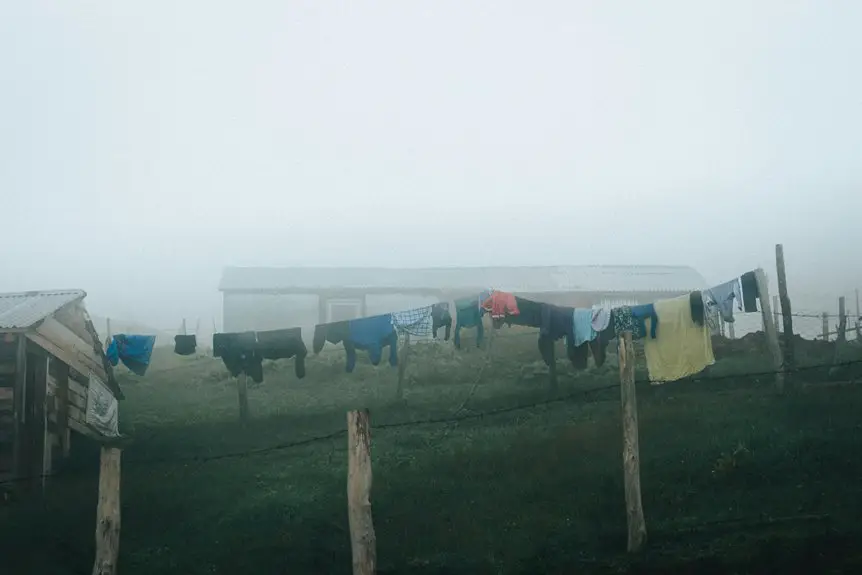To prevent mildew on clothes in humid climates, choose breathable fabrics like linen or wool that resist moisture. Wash your clothes in hot water with a quality detergent and dry them thoroughly, either in a dryer or in a well-ventilated area. Store clothes in open shelving with good airflow, avoiding overcrowding. Consider using a dehumidifier to keep humidity levels down. If you want more tips on combating mildew, just explore further!
Table of Contents
Key Takeaways
- Choose moisture-wicking fabrics like linen or wool to reduce mildew risk in humid environments.
- Wash clothes in hot water with mildew-fighting detergent to eliminate spores effectively.
- Ensure clothes are completely dry before storing; use a dryer or hang them in well-ventilated areas.
- Store clothes in open shelving with good airflow, avoiding overcrowding to prevent moisture buildup.
- Use a dehumidifier in storage areas to maintain low humidity levels and minimize mildew growth.
Understanding Mildew and Its Causes
Mildew thrives in warm, damp environments, so understanding its causes can help you protect your clothes. It often develops when moisture levels rise, especially in humid climates or poorly ventilated spaces.
When you leave wet clothes in a pile or forget about damp towels, you create the perfect breeding ground for mildew. Additionally, high humidity can increase the likelihood of mildew growth even in clean, dry fabrics.
You mightn’t realize that storing clothes in dark, confined spaces can also contribute to this issue. To prevent mildew, make certain your laundry is completely dry before storing it, and keep your storage areas well-ventilated.
Choosing the Right Fabrics
When selecting fabrics for your wardrobe, consider how different materials can impact mildew growth. Some fabrics are more prone to trapping moisture and creating an ideal environment for mildew.
By choosing wisely, you can keep your clothes fresh and free from that musty odor. Here are some fabric options to think about:
- Cotton: Breathable and lightweight, but can absorb moisture.
- Linen: Naturally moisture-wicking, great for humid climates.
- Synthetic blends: Often resistant to mildew, but check for breathability.
- Wool: Naturally resistant to mildew and moisture, keeping you cozy.
Proper Washing Techniques
Maintaining your clothes isn’t just about selecting the right fabrics; proper washing techniques play a crucial role in preventing mildew.
First, always wash your clothes in hot water when possible, as it helps kill mildew spores. Use a quality detergent with mildew-fighting properties for extra protection.
Don’t overload your washing machine, as this can prevent proper cleaning and rinsing. Make sure you rinse clothes thoroughly to remove any detergent residue, which can also promote mildew growth.
If you’ve got particularly susceptible items, consider adding a cup of white vinegar during the rinse cycle.
Finally, wash your clothes regularly to avoid mildew buildup, especially during humid months.
Effective Drying Methods
After washing your clothes with the right techniques, how you dry them is just as important in preventing mildew.
To keep your garments fresh and mold-free, consider these effective drying methods:
- Use a dryer: If you have one, the heat will help eliminate moisture quickly.
- Hang in a well-ventilated area: Air circulation is essential. Choose a spot with good airflow to let your clothes breathe.
- Avoid damp spaces: Steer clear of drying clothes in basements or other humid areas where mildew thrives.
- Use a dehumidifier: If you live in a particularly humid climate, a dehumidifier can help maintain a dry environment for drying your clothes.
Smart Storage Solutions
When it comes to storing your clothes, proper airflow is essential to preventing mildew.
You should also consider using moisture absorbers to keep your storage area dry.
These smart storage solutions can make a big difference in maintaining the freshness of your wardrobe.
Proper Airflow Techniques
To prevent mildew from forming on your clothes, guaranteeing proper airflow in your storage areas is essential.
It’s not just about keeping your clothes clean; it’s about protecting your favorite pieces and the memories they hold.
Here are some techniques to improve airflow:
- Use open shelving: It allows air to circulate freely around your clothes.
- Add ventilation: Ensure your storage area has windows or vents to promote fresh air flow.
- Avoid overcrowding: Don’t cram your clothes together; give them space to breathe.
- Utilize breathable storage bags: These can help manage moisture while allowing air circulation.
Use of Moisture Absorbers
While ensuring proper airflow is important for preventing mildew, using moisture absorbers can greatly enhance your clothes’ protection. These handy products draw moisture from the air, keeping your storage areas dry. You can choose from various options, including silica gel packets, activated charcoal, or commercial moisture-absorbing bags.
Here’s a quick comparison to help you decide:
| Type | Effectiveness |
|---|---|
| Silica Gel Packets | Good for small spaces |
| Activated Charcoal | Eco-friendly option |
| Commercial Bags | High capacity & easy to use |
Utilizing Dehumidifiers
Using dehumidifiers can greatly reduce the moisture levels in your home, making it harder for mildew to thrive on your clothes. By keeping humidity at bay, you create a healthier environment for your garments.
Here are some benefits of using dehumidifiers:
- Protects your investments: Your favorite clothes deserve care and protection.
- Improves air quality: Breathe easier knowing you’re reducing allergens and odors.
- Prevents costly replacements: Avoid the expense of replacing moldy or damaged items.
- Enhances comfort: Enjoy a more pleasant living space, free from dampness.
Investing in a dehumidifier not only safeguards your clothes but also elevates your overall living experience.
Take control of your home’s humidity and keep your wardrobe fresh!
Regular Maintenance and Cleaning
Maintaining a clean and organized laundry space is just as important as controlling humidity levels. Regularly clean your washing machine, as residue can promote mildew growth.
Wipe down surfaces and keep laundry baskets dry and free of dampness. Always allow your clothes to dry completely before putting them away; don’t forget to check under the bed or in closets where moisture might linger.
You should also inspect your clothes periodically for any signs of mildew, especially if they’ve been stored for a while. If you find any spots, wash those items immediately with hot water and a strong detergent.
Tips for Travel in Humid Conditions
Traveling in humid conditions can pose challenges for keeping your clothes fresh and mildew-free. To enjoy your trip without worrying about musty smells or damp fabric, follow these handy tips:
- Pack moisture-wicking fabrics: They dry quickly and help control humidity.
- Use breathable bags: Opt for mesh or cotton to allow airflow and reduce moisture buildup.
- Include silica gel packs: Toss a few in your suitcase to absorb excess moisture.
- Air out your clothes: Whenever possible, hang your garments in well-ventilated areas to keep them fresh.
Frequently Asked Questions
Can Mildew Affect Synthetic Fabrics Differently Than Natural Fabrics?
Mildew can impact synthetic fabrics differently than natural ones. While synthetic materials resist moisture better, they can still harbor mildew if damp. Natural fabrics absorb moisture, making them more susceptible to mildew growth and odor.
How Can I Tell if Mildew Has Formed on My Clothes?
Mildew’s sneaky like a shadow, creeping onto your clothes. You’ll spot it as dark spots or patches, often with a musty smell. If your fabric feels damp, it’s time to investigate further!
What Are the Health Risks Associated With Mildew on Clothes?
Mildew on clothes can lead to respiratory issues, skin irritation, and allergic reactions. It’s important to stay alert for these health risks, especially if you’re sensitive to mold or have existing respiratory conditions.
Are There Specific Detergents That Prevent Mildew Growth?
When mildew’s lurking, you need a shield. Certain detergents, like those with mildew-fighting ingredients, can help you keep your clothes fresh. Look for products labeled “mildew resistant” to guarantee your wardrobe stays safe from mold.
Can Mildew Grow in Sealed Plastic Storage Bins?
Yes, mildew can grow in sealed plastic storage bins if moisture is trapped inside. To prevent this, guarantee items are completely dry before storing and consider adding moisture absorbers to keep the environment dry.
- Where to Buy Sherpa Suede Fabric - July 12, 2025
- How to Draw or Illustrate the Texture of Suede Fabric - July 12, 2025
- What Is Baseball Suede Leather Fabric? - July 12, 2025





